We may earn revenue from the products available on this page and participate in affiliate programs.
So you’re ready to invest in a solar charger. The first thing to know is that a solar charger is really two products: a solar panel and a power bank. The former turns the power of the sun into electricity, while the latter stores that electricity for you to use at a later time (such as the evening or nighttime). To help you choose the best solar charger setup for your needs, I tested a sample of models from some of the top names in solar power.
- Best for Overlanding: Jackery Solar Generator 1000 Pro
- Best Value: Anker 625 Solar Panel and the Anker 555 PowerHouse
- Best for Backpackers: Goal Zero Nomad 10 and Venture 35
- Best for Smartphones: BioLite SolarPanel 5+
- Best Handheld: 4PATRIOTS Portable Solar Power Bank
Best for Overlanding: Jackery Solar Generator 1000 Pro
Why It Made the Cut
This impressive setup powered a 1002Wh battery in two hours—that’s enough juice to charge your laptop over twelve times.
Key Features
- Max power output: 1000W (120V) from the AC port
- Weight: 57.4 pounds (25.4 pounds for the Explorer 1000 Pro and 8 pounds each for the four SolarSaga 200)
- Ports: Three AC, two USB-C, two USB-A, car port
- Also available as a package with the Solar Generator 1000 Pro and two SolarSaga 80 units
- Warranty: Five years
Pros
- Exceptionally fast charging time
- Intuitive setup
- Enough power for most home electronics
Cons
- Expensive
- Heavy (though not especially bulky)
- Lots of cords
Product Description
There is a lot to unpack with the Jackery Solar Generator 1000 Pro. First is the battery itself, the Jackery Explorer 1000 Pro, and its AC and car charging cables, along with two cable adapters (these were not needed during my testing of this unit). This is over 25 pounds, making it transportable, but not something that you’d want to lug more than a hundred feet or so at a time. Next is the four SolarSaga panels (8 pounds each), each with its own carrying case and a cable that connects back to the two DC ports on the Explorer 1000 Pro. If you’re seeing a math problem here, that’s correct: You’ll also need two of the Jackery Solar Panel Connectors, which, strangely, are not included in the purchase price. Two of these can be used to double the number of panels you can connect to the Explorer 1000 Pro.
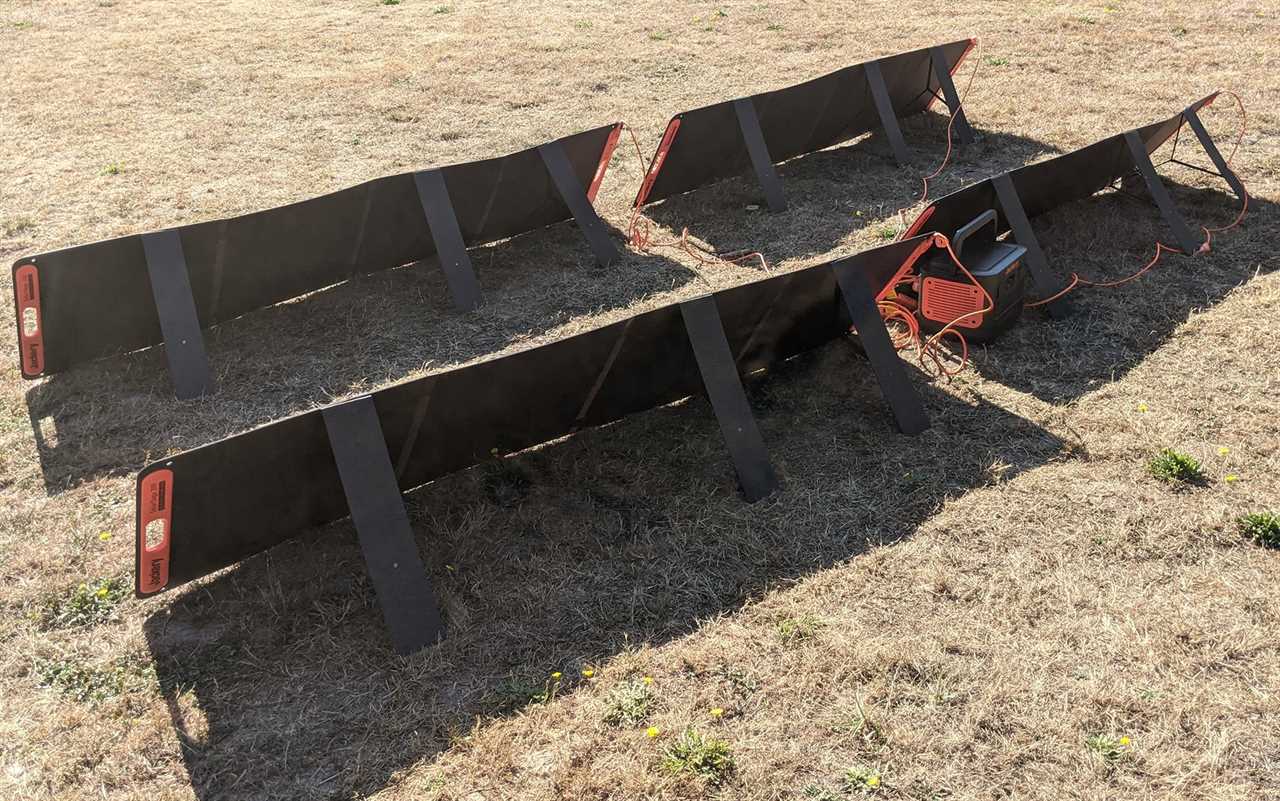
Each of the panels has three kickstands, which provided plenty of stability during testing. Laura Lancaster
Setting up and taking down this many panels takes some time, but I was impressed by how easy and intuitive it was. That’s because Jackery streamlined the number of ports on each unit, making it that much clearer what cable connects to what unit in what port.
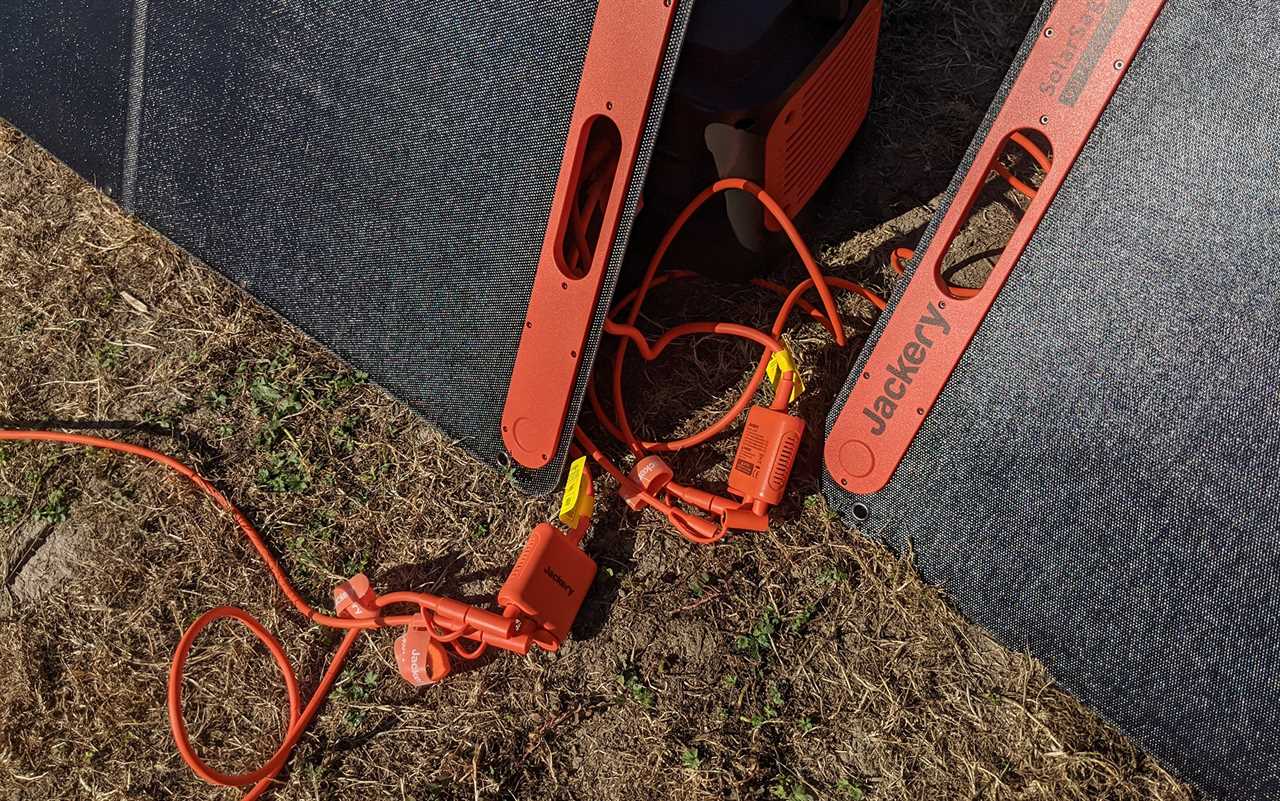
Four cables from each of the panels connected to two solar panels hooked up to the battery makes for a big cable-y mess. Laura Lancaster
During testing (direct sunlight on a lightly hazy day), the Explorer 1000 Pro went from 1 percent battery up to 100 percent in about two hours, registering an input of just over 650W until it got to the end of charging, where it dropped to about half that.

It ended up taking less than the 1.2 hours listed here to finish charging this 1002Wh battery. Laura Lancaster
The Explorer 1000 Pro has a max outpeak of 1000W (peaking at 2000W), which is enough juice to power many modern refrigerators. But given that its battery life is only 1002Wh, it can’t provide that kind of power output for long unless it’s also being supplied with fresh juice from the solar panel setup at the same time. For some, this won’t be an issue, as they’ll simply be using the battery to channel power to their other devices during the day while it’s charging, and then using the battery at night to power more low-key items like the best camping fans or maybe one high-energy device like a portable fridge.
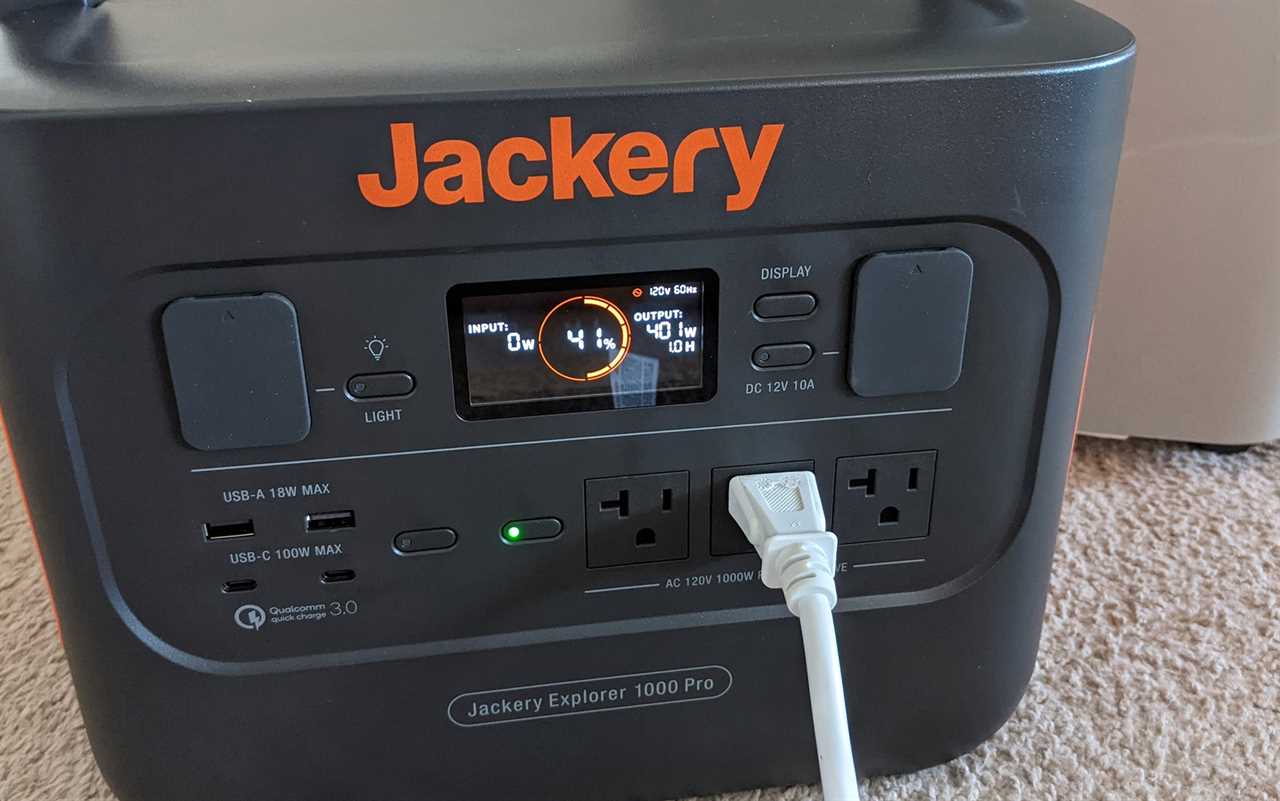
One of the most power-hungry appliances in my home is a dehumidifier, which was on track to take down a fully charged Explorer 1000 Pro in a couple of hours. Laura Lancaster
While there might at first glance appear to be a disconnect between the charging time capabilities of this setup and its battery life, it’s worth keeping in mind that conditions are not always optimal. One of the things that has impressed me most about these units is the panels ability to generate electricity in lowlight conditions. Even in complete shade—dusk fast approaching—the Explorer 1000 pro would show a 6W input from just one panel. For overlanders with high energy needs or camper vans that want to power some of their setup from a more sustainable generator, this is an excellent choice that won’t take up an excessive amount of space in your rig.
Best Value: Anker 625 Solar Panel and the Anker 555 PowerHouse
Why It Made the Cut
Thoughtful features on this powerful duo, including an integrated sundial and the ability to charge from USB-C, make this a great value for anyone that isn’t relying on solar alone for their power needs.
Key Features
- Max power output: 1000W (110V) from the AC port
- Weight: 40.8 pounds (29.8 pounds for the 555 PowerHouse and 11 pounds for the 625 Solar Panel)
- Ports: Six AC, three USB-C, two USB-A, car charger
- Units sold separately
- Warranty: Five years
Pros
- Impressive solar power output for its size and cost
- Able to charge the power station via a USB-C cable
- Largest power station in my test
Cons
- Panel is less stable than others I tested
- Power station has a max input of 200W
- 110V max output is just below the needs of many major electronics
Product Description
I was already a fan of the Anker 625 Solar Panel from my test of the best solar panels for camping, so it made sense to pair it with one of Anker’s power stations. The Anker 555 PowerHouse may be the younger sibling of the 757 PowerHouse (a 1224Wh beast), but, at 1024Wh, it was still the largest power station I looked at. While, at first glance, this is a similar unit to the slightly smaller Jackery Explorer 1000 Pro, there are some important differences that are worth noting.

I was able to charge two power banks simultaneously from the Anker 625 Solar Panel while charging my phone from the Anker 555 PowerHouse. Anker
First off, it has a power-saving mode so that the unit stops sending power to your devices once they are fully charged (useful, if you are powering something overnight). Next, there were three USB-C ports (compared to the two on the Jackery unit). As USB-C continues to become the norm in charging cables, there will be a greater demand for these ports compared to the USB-A and even AC ports (especially if you are primarily using your power bank to power electronics). I also appreciated that there was an option to charge the Anker 555 PowerHouse directly from one of the USB-C ports (especially given that I’ve already misplaced the DC wall charging cable the unit came with). Between phones and laptops, these cables are fairly interchangeable at this point, making it easier to recharge your unit on the fly. It could also be charged (via a wall unit or solar panel) using a DC7909 cable—the most common power input cable I’ve seen while reviewing these products.
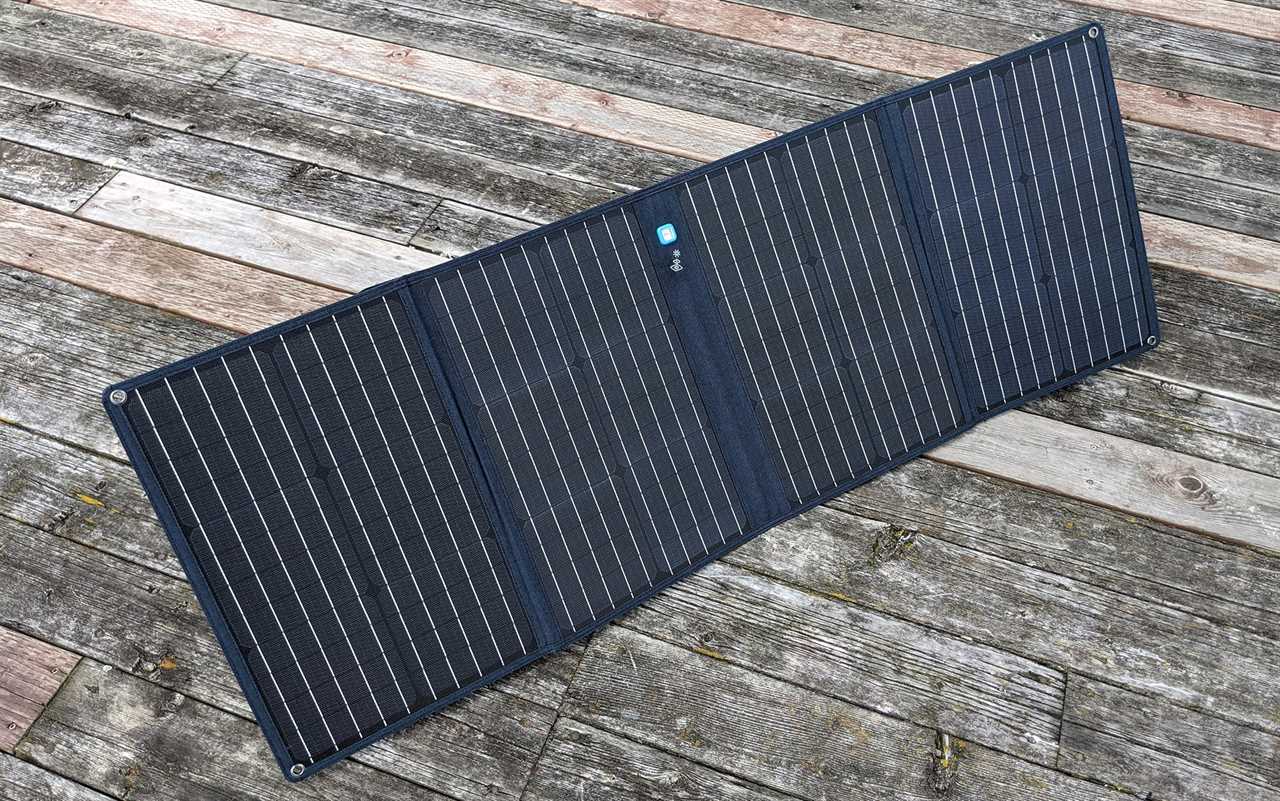
The Anker 625 Solar Panel provides serious power at an approachable price point. Laura Lancaster
Strangely, the Anker 625 Solar Panel does not charge via a DC7909 cable, but rather the less common XT port (which is directly compatible with their 757 unit). Anker provides an adapter so that it works with the 555 PowerHouse, but the more small pieces like that you have floating around, the more likely it is that something will go missing over time. As mentioned in my earlier review, this panel is one of the easiest to optimize the positioning of, using the integrated sundial and three kickstand legs—in fact, during testing, I set this panel up first (where it achieved 89W—not bad for a 100W panel on a hazy day) and then positioned the rest to match its angle and direction. I still would have been able to achieve the impressive power output seen with the Jackery Solar Generator 1000 Pro without this assist, but it would have taken more fiddling, moving the panel into position, checking the input on the power station, and then adjusting: rinse, wash, repeat.
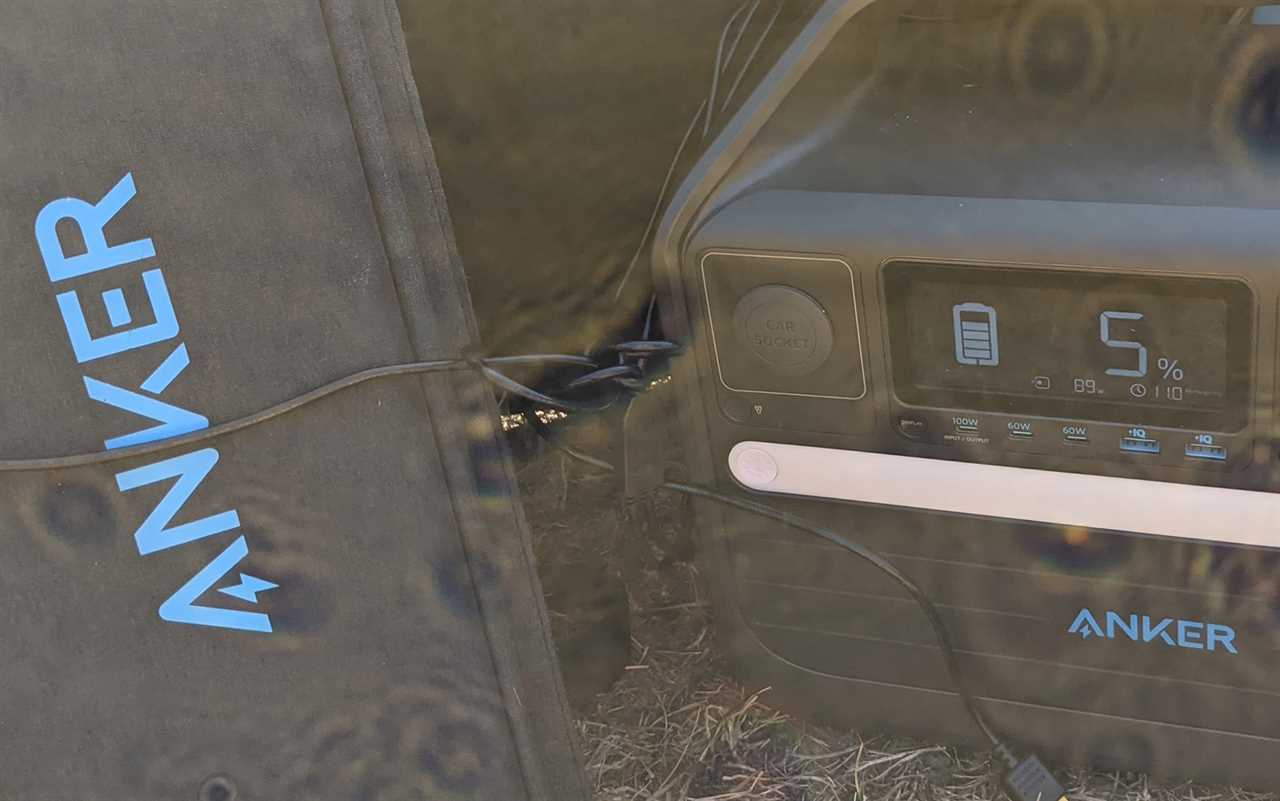
While testing in full sun, a single Anker 625 Solar Panel was able to produce 89 watts of power—not bad for a 100 watt panel. Anker
While ultimately this pairing isn’t strong enough for individuals who expect to deplete a 1024W power station on a daily basis, it does provide plenty of oomph for those looking to extend the life of their power station without investing thousands of dollars into a larger setup.
Best for Backpackers: Goal Zero Nomad 10 and Venture 35
Why It Made the Cut
This lightweight yet powerful Goal Zero combo could easily keep two backpackers’ phones charged while in the backcountry.
Key Features
- Max power output: 18W from the USB-C port
- Weight: 1.7 pounds (0.6 pounds for the Venture 35 and 1.1 pounds for the Nomad 10)
- Ports: One USB-C, two USB-A
- Units sold separately
- Warranty: Two years
Pros
- Lightweight
- Low profile
- Affordable
- Choose from different size solar panels and chargers depending on your power needs
Cons
- Needs the better part of a day to fully charge via sun
- Solar panel only supports USB-A
Product Description
While price and power are the two biggest considerations for overlanding, car camping, and prepping, when you’re carrying everything you’ll need on your back, another consideration comes to the fore: weight. While there are several all-in-one options available that prioritize either the solar part of solar chargers or the charger (power bank) part, the best way to maximize your available power in the backcountry is to purchase the solar panel and power bank separately.
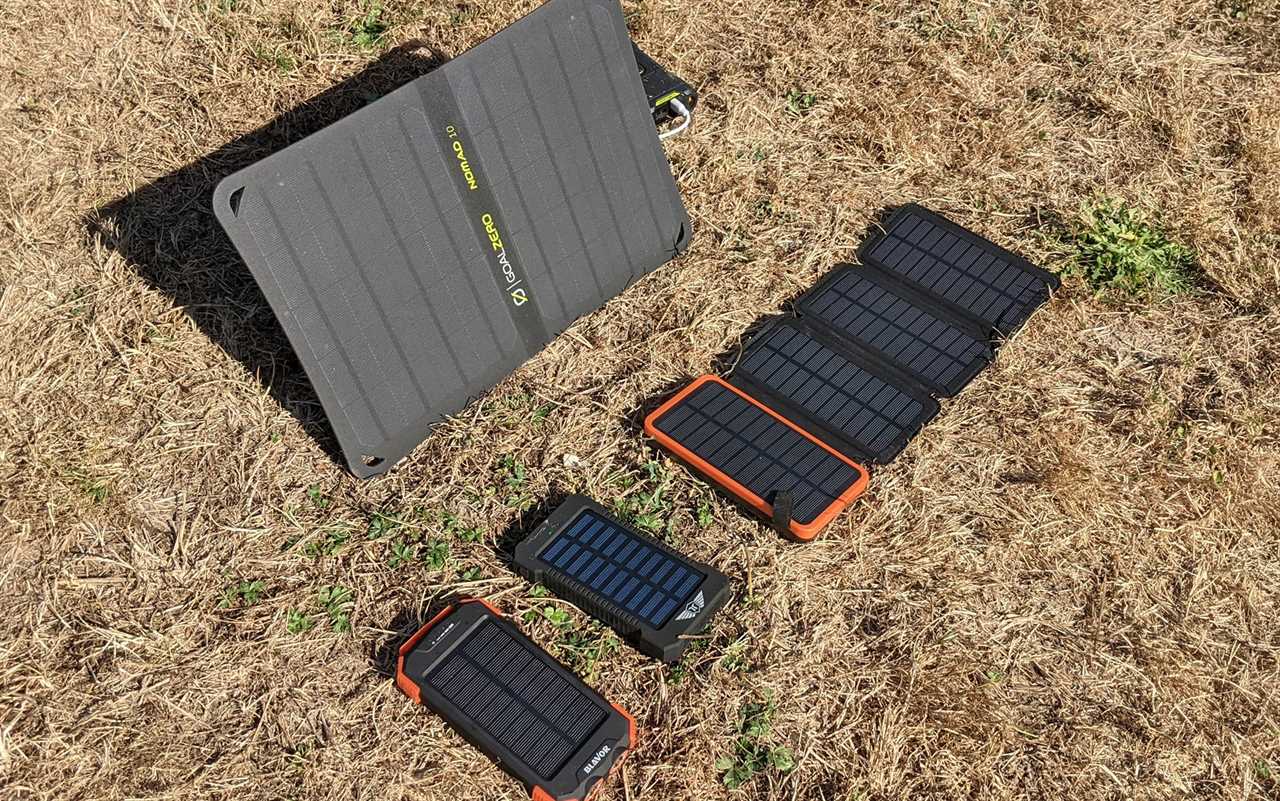
Testing the Goal Zero Nomad 10 and Venture 35 combo along with a smorgasbord of smartphone-sized solar chargers. Laura Lancaster
Goal Zero products are great for backpackers and backpack hunters because they offer a wide range of power capabilities, everything from a single 5W Nomad 5 solar panel (12.7 ounces) and lipstick-tube-sized 12Wh Flip 12 charger (2.5 ounces) up to the 20W Nomad 20 (2.3 pounds) and 71Wh Venture 75 (20.4 ounces). But my favorite combo is the 10W Nomad 10, paired with the 35Wh Venture 35.
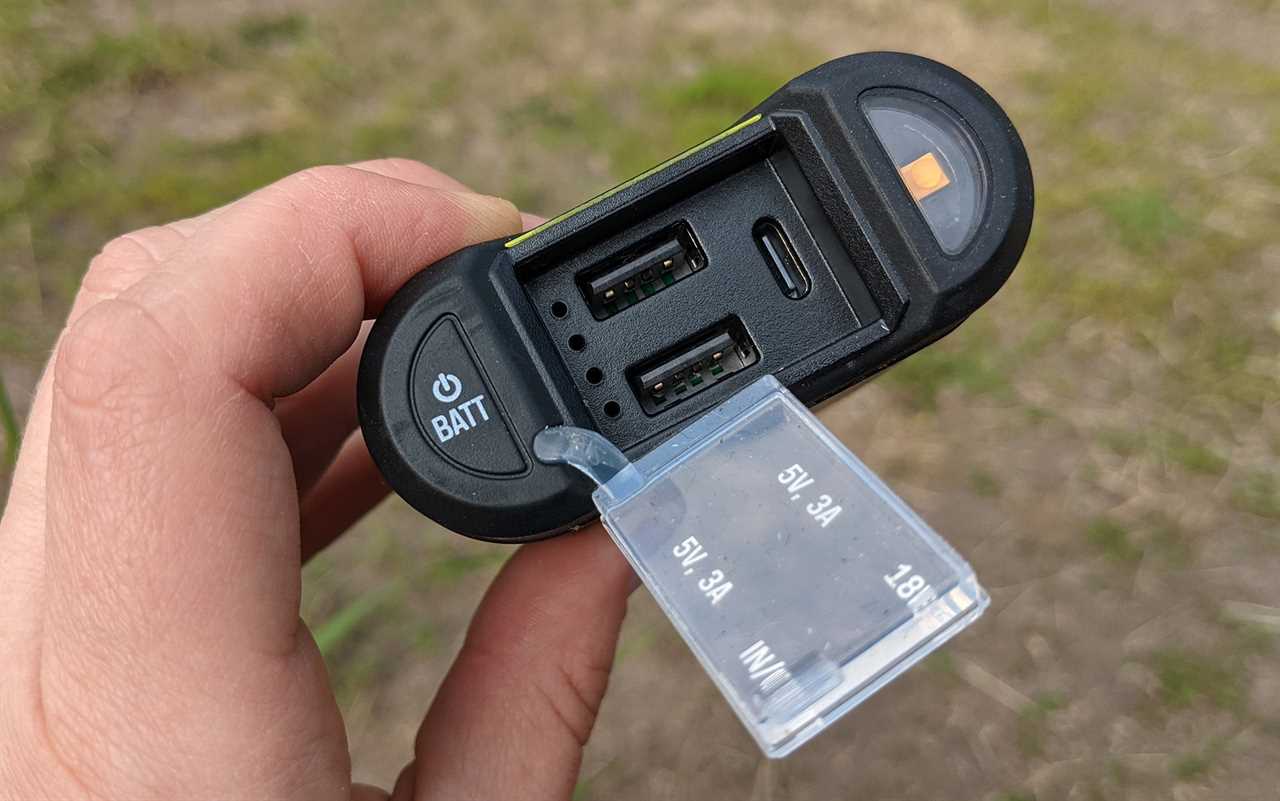
The Goal Zero Venture 35 is virtually weatherproof—an unusual feature for battery packs that anyone who spends time outdoors will find useful. Laura Lancaster
With this setup, you can top off your power bank while sipping coffee in the morning or setting up camp in the evening—no need to have a solar panel hanging off the back of your pack all day—and still have plenty of power for the next day.
Best All-in-One: BioLite SolarPanel 5+
Why It Made the Cut
This low-profile solar panel features a built-in battery large enough to recharge your smartphone after the sun sets.
Key Features
- Max power output: 5W
- Weight: 13.8 ounces
- Ports: USB-A
- Also available in SolarPanel 10+
- Warranty: One year
Pros
- 8Wh battery is integrated into the panel
- Affordable
- Small and lightweight
- Integrated sundial and adjustable kickstand
Cons
- Slow charging time
- Performs poorly in even slightly cloudy weather
Product Description
Of the units I looked at with an integrated battery pack and solar panel, I was most impressed by the BioLite Solar Panel 5+. While not as powerful as comparatively priced battery packs, some individuals (especially those who live in reliably sunny climes) will appreciate the flexibility and on the-go-charging capabilities.
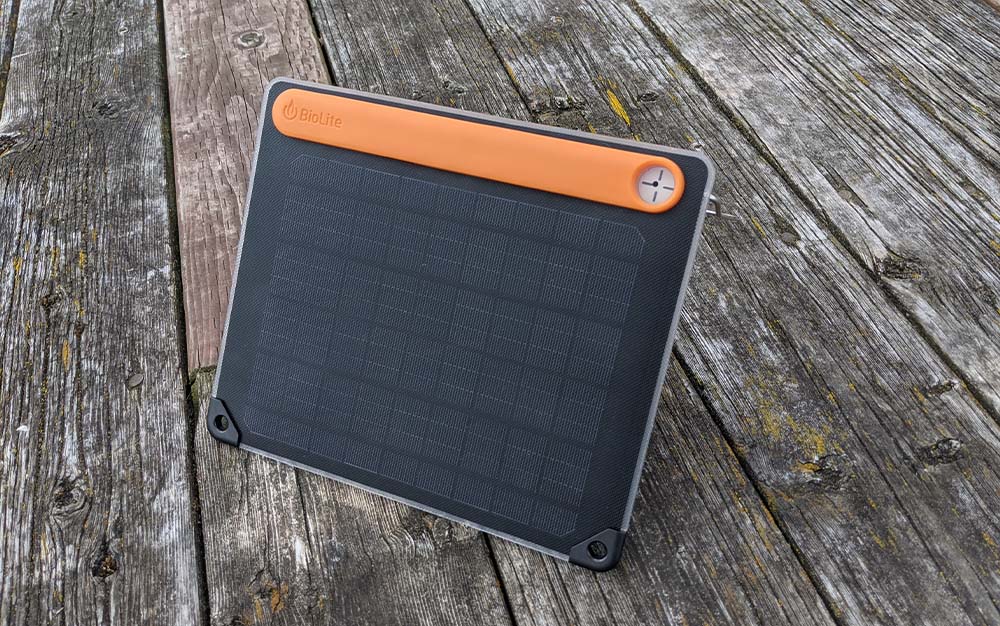
The internal battery and sundial helped make up for some of the missing oomph with the BioLite Solar Panel 5+. Laura Lancaster
While the max output of the BioLite Solar Panel 5+ is only 5 watts, it’s enough to get your smartphone going again. I also liked that it featured an adjustable kickstand and an integrated sundial, which I used to optimize the positioning of the panel during testing. Though it took the BioLite Solar 5+ 22 minutes to charge my phone 5 percent, it was fairly cloudy when I originally tested this model. The BioLite’s onboard 3,200 mAh battery can also be charged via a micro USB port, and was found after several months of testing to still hold a full charge.
Best Handheld: 4PATRIOTS Portable Solar Power Bank
Why It Made the Cut
While none of the handheld units I tested lived up to the “solar” part of “solar charger,” they did at least function as reasonable power banks.
Key Features
- Max power output: 5W
- Weight: 10 ounces
- Ports: USB-A, micro USB
- Warranty: One year
Pros
- The least expensive unit I looked at performed about as well as the others in my test
- Low profile that would work well in a glove box
Cons
- Solar panel provides negligible power
Product Description
While the power output to price ratio of solar panels has plummeted in recent years, an effective setup is still an investment. Even if all you’re looking to do is charge your phone with solar, $100 or more is not an uncommon price tag. So it’s no wonder that power banks with solar panels slapped on the back, which are often a quarter of that price tag, have become so popular. To find out how effective they are, I called in four of the most popular models from 4PATRIOTS, Solvolt, Blavor, and Hiluckey.
The good news is that all four of these are effective power banks. So if you’ve charged one in your wall outlet and tossed it into your glove box, it should still have plenty of juice. The bad news is that the solar panels on these units seem to be largely decorative—even after leaving these in the sun for multiple days, I was not able to achieve anywhere near a full charge (most were still working on the first bar of charging). There are a few reasons this could be the case. The first is that the battery pack itself could be overheating in the sun. It’s easy enough to keep the BioLite Solar Panel 5+ and the Goal Zero combo batteries in the shade of the panel; however, the handheld units are getting a full blast of sunlight. Another reason could be that the solar panels are just too small and/or not high quality enough to do what the unit is designed to do. So if you’re wondering, “Do solar phone chargers really work?”—the answer appears to be not really. Consider one of the best power banks for camping instead.
Things to Consider Before Buying a Solar Charger
Intended Purpose
Your power needs are going to be dramatically different if you’re looking for a backup power supply for your phone versus keeping the heat on during a days-long blackout. Before you purchase something, first compare the voltage/ampere requirements of your device (typically found in small print on the back) to what the power bank can offer. (Using an online calculator can help fill the gaps if some of this information is missing.) Power banks that produce less voltage/amps than you need will either malfunction or simply not work at all for that purpose.
Power Bank Capacity
The power banks I looked at as part of this review varied in size from 8Wh (which will power your smartphone once) all the way up to 1024Wh (which could power your phone over 25 times). There were also considerable differences in their voltage capabilities, from 5V (slow charge times for your phone, but doable) all the way up to 120V (which is sufficient for many heavy duty electronics like modern refrigerators).
Maximum Solar Panel Output
There is a huge difference in the quality and power (and size) of solar panels at different price points. The smallest solar panels I looked at—the “solar chargers” for sale on Amazon only—produced so little power (if any at all) to be virtually unusable, while some of the larger and more powerful setups could charge up the largest power bank in a couple of hours. If you have a specific purpose in mind, consider what your needs and budget are before committing to a purchase.
FAQs
Q: How much do solar chargers cost?
While there are solar chargers for sale on Amazon for as little as $20, solar chargers capable of converting sunlight to electricity typically start at $100 and go up to as much as $6,000.
Q: Do solar chargers work on cloudy days?
Yes. While they will work much more slowly on cloudy days than they do in full sunlight, quality solar chargers will work on cloudy days.
Q: What is a good mAh for a solar charger?
A 10,000 mAh is plenty of power to recharge your phone a couple of times—if you are looking to power a laptop, something in the 30,000 mAh range will work better. Another important consideration is the amperes, or amps. If your solar charger is only capable of 1 amp, it will have a significantly slower charging time than one that can deliver 2 amps.
Methodology
I considered a number of criteria in evaluating the best solar chargers, including:
Battery Life: I evaluated the power banks over the course of several months, charging and recharging the units multiples times, checking to see if power was lost when not in use, and whether the stated power bank size matched the capabilities of the unit.
Solar Output: After testing, it’s clear that some so-called solar chargers are really power banks with decorative solar panels on the back. Others are capable of delivering such an impressive amount of electricity that they could be used both for power generation while traveling and in the event of a blackout.
Price: Since there is an unusually wide range of price points for solar chargers, I took into consideration what provides the best value for individuals looking to engage in different activities.
Portability: All units were carried for a minimum of fifty yards, and set up by a single person, to assess how easy they were to handle.
Functionality: I looked at how easy (or difficult) a unit was to set up initially, and then how well they worked to power my devices over a period of several months.
Final Thoughts
The best solar charger for your needs depends on a number of factors, including your budget, your power needs, and the available sunlight in the region. After using several models over the course of several months, I provided the above recommendations based on ease of use, intended function, and power bank size.
The post The Best Solar Chargers of 2022 appeared first on Outdoor Life.
By: Laura Lancaster
Title: The Best Solar Chargers of 2022
Sourced From: www.outdoorlife.com/gear/best-solar-chargers/
Published Date: Sun, 25 Sep 2022 13:06:06 +0000
----------------------------------------------
 Backyard GrillingWeekend WarriorsAdvice from DadBeard GroomingTV Shows for Guys4x4 Off-Road CarsMens FashionSports NewsAncient Archeology World NewsPrivacy PolicyTerms And Conditions
Backyard GrillingWeekend WarriorsAdvice from DadBeard GroomingTV Shows for Guys4x4 Off-Road CarsMens FashionSports NewsAncient Archeology World NewsPrivacy PolicyTerms And Conditions
